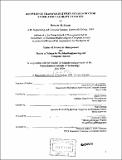| dc.contributor.advisor | Arnold Barnett and Duane Boning. | en_US |
| dc.contributor.author | Braum, Roberta M. (Roberta Michelle), 1971- | en_US |
| dc.date.accessioned | 2005-08-19T19:59:30Z | |
| dc.date.available | 2005-08-19T19:59:30Z | |
| dc.date.copyright | 1999 | en_US |
| dc.date.issued | 1999 | en_US |
| dc.identifier.uri | http://hdl.handle.net/1721.1/9761 | |
| dc.description | Thesis (S.M.)--Massachusetts Institute of Technology, Sloan School of Management; and, (S.M.)--Massachusetts Institute of Technology, Dept. of Electrical Engineering and Computer Science, 1999. | en_US |
| dc.description | Includes bibliographical references (p. 57). | en_US |
| dc.description.abstract | A reduction in the time and resources required for startup and ramp of a semiconductor fabrication facility is necessary to maintain competitiveness in manufacturing operations. This research describes and examines a method developed to augment the knowledge transfer of startup processes, as well as some of the other methodologies currently used for organizing and managing the facility startup. The research focuses on what steps can be taken to learn from past startups and integrate that knowledge into future startup processes. Questions arise for any company regarding what system to implement for knowledge transfer. The primary criteria that should be examined for any location should include a cost / benefit analysis, understanding the trade-off between flexibility and standardization, and the resources required to manage the knowledge transfer. For a factory startup, the incentives, benefits, and resource issues differ from that of an on-going factory. As the startup has limited benefits from transferring their knowledge, creating a system that is easy for them to use and/or is useful during the startup period is ideal. Also, as the startup is a period of high activity the system should be part of the regular activity for both the giving and the receiving sites. The knowledge transfer system described in this thesis is made up of a documentation process, conference, and web site. The method of implementation and the effectiveness of each method will be discussed, as well as possible future developments. | en_US |
| dc.description.statementofresponsibility | by Roberta M. Braum. | en_US |
| dc.format.extent | 66 p. | en_US |
| dc.format.extent | 4694194 bytes | |
| dc.format.extent | 4693954 bytes | |
| dc.format.mimetype | application/pdf | |
| dc.format.mimetype | application/pdf | |
| dc.language.iso | eng | en_US |
| dc.publisher | Massachusetts Institute of Technology | en_US |
| dc.rights | M.I.T. theses are protected by copyright. They may be viewed from this source for any purpose, but reproduction or distribution in any format is prohibited without written permission. See provided URL for inquiries about permission. | en_US |
| dc.rights.uri | http://dspace.mit.edu/handle/1721.1/7582 | |
| dc.subject | Sloan School of Management | en_US |
| dc.subject | Electrical Engineering and Computer Science | en_US |
| dc.title | Knowledge transfer between semiconductor fabrication facility startups | en_US |
| dc.type | Thesis | en_US |
| dc.description.degree | S.M. | en_US |
| dc.contributor.department | Massachusetts Institute of Technology. Department of Electrical Engineering and Computer Science | en_US |
| dc.contributor.department | Sloan School of Management | en_US |
| dc.identifier.oclc | 42799696 | en_US |
